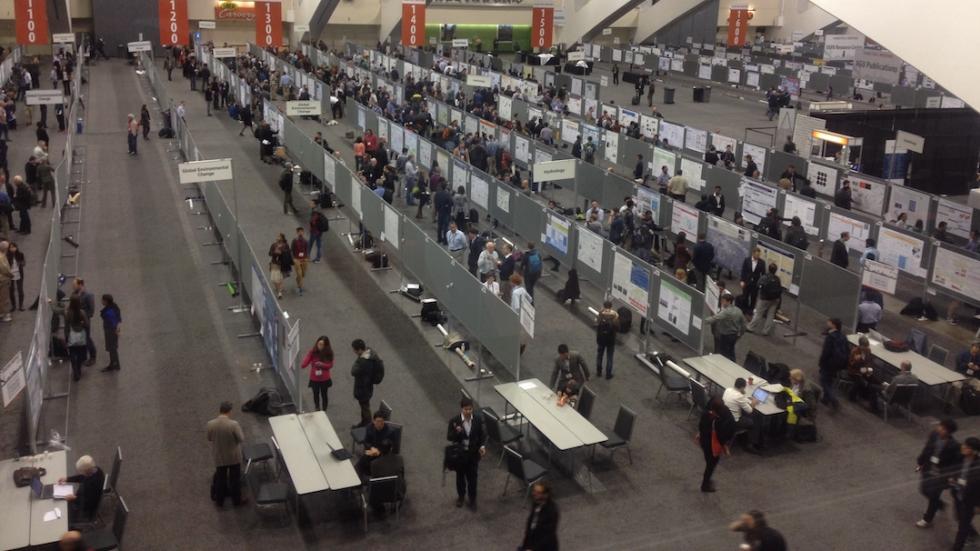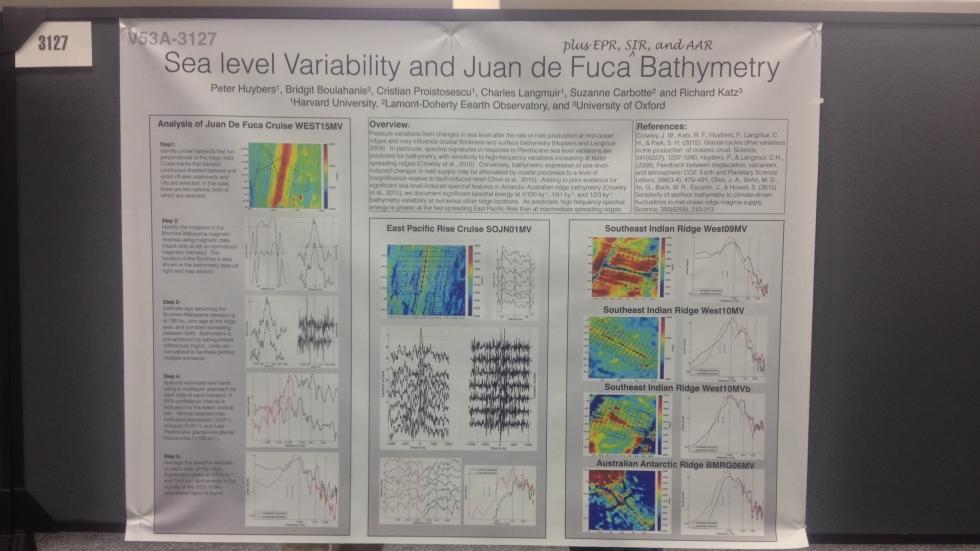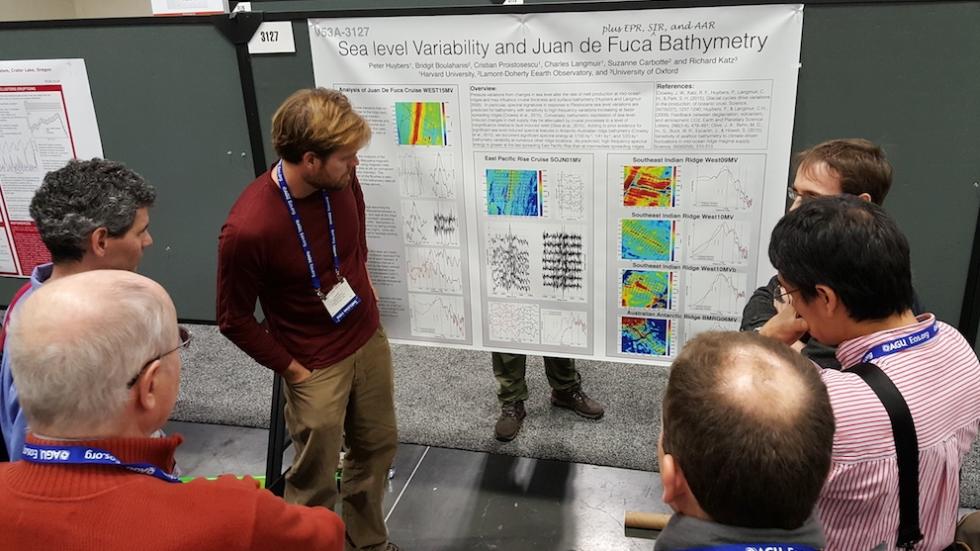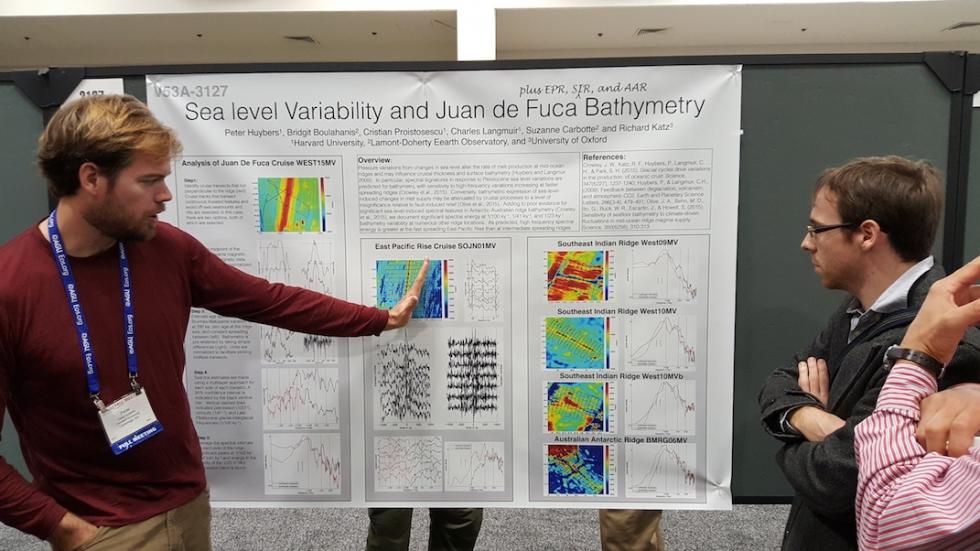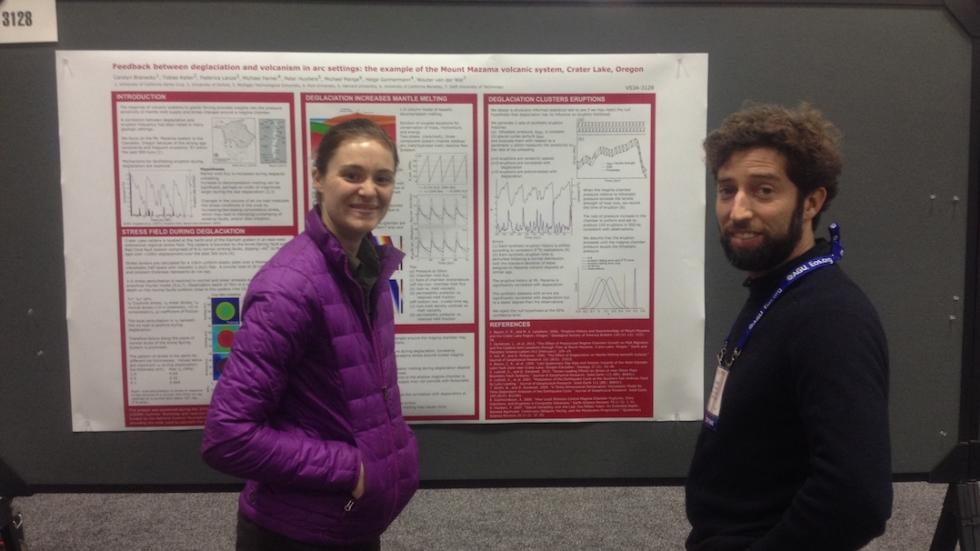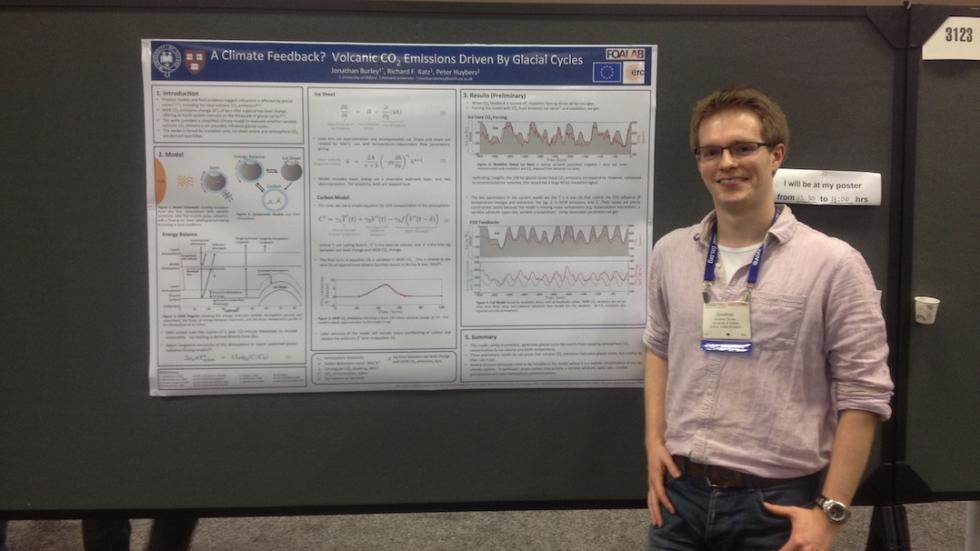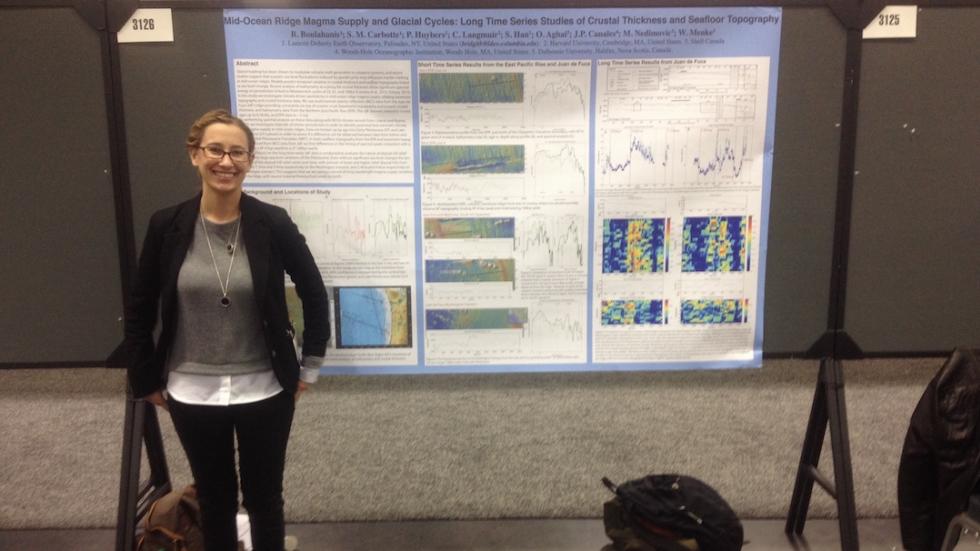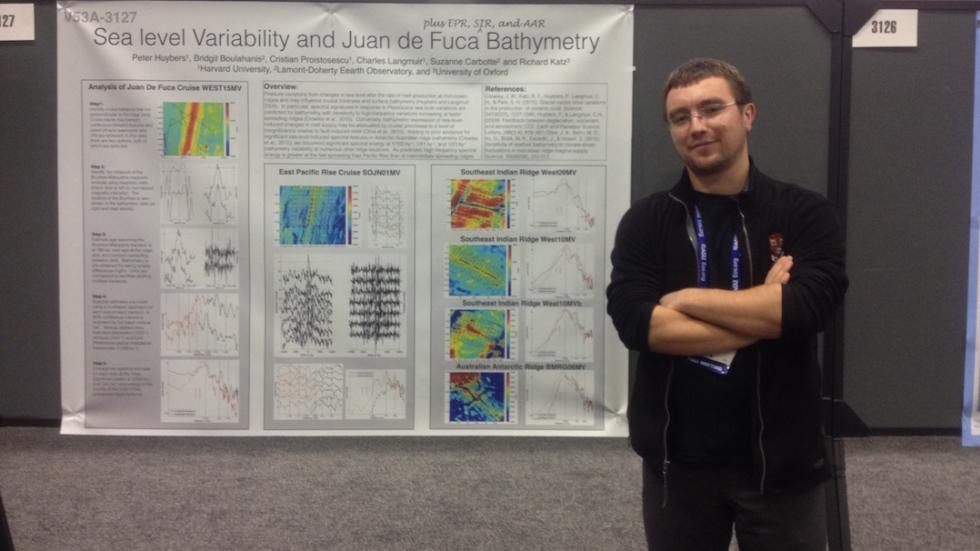2015 AGU Session (9126)
Suzanne Carbotte (Columbia University)
Charles Langmuir (Harvard University)
SeaVOICE: Sea-going Experiments to Test Potential Linkages among Sea Level Change, Ocean Ridge Volcanism, and Hydrothermal Activity. (81365)
Abstract:
Changes in sea level influence the pressure of the solid Earth over entire ocean basins. While the absolute changes in sea level caused by glacial cycles are small relative to ocean depths, the temporal variations in sea level can lead to pressure changes of similar order to mantle upwelling rates, with the potential to significantly perturb short term rates of melt production at ocean ridges (Huybers and Langmuir, EPSL, 2009). Such changes could then lead to fluctuations in crustal thickness, magma composition and hydrothermal activity. To investigate possible relationships between glacial cycles and ocean ridge processes, we carried out an 18 day cruise of mapping and sediment coring to the Cleft Segment of the Juan de Fuca ridge. High resolution bathymetry was obtained on the west side of the ridge axis to beyond 1Ma to test whether abyssal hill fabric shows periodicities consistent with glacial cycles. Nine successful piston cores up to 7.6m in length provide a sedimentary record back to more than 600kyr to test for spatial and temporal variations in hydrothermal activity. Oxygen isotope stratigraphy on these cores is systematic and provides good age constraints. Short cores near the ridge axis provide a record of the current trace of hydrothermal activity in youngest sediments. Several of the cores impacted basement and recovered a basement sample. Above basement, basaltic glass shards were recovered in the bottom meter of sediment, raising the possibility of temporal records of basalt chemical compositions using the age constraints the sediments provide. The glass samples provide a unique and new perspective on ridge volcanism, since previous off-axis samples were restricted to dredging old fault scarps. Cores can be taken anywhere, raising the potential for global time series studies of ridge volcanism. The coupled bathymetry, sediment geochemistry and magmatic glass compositions hold the promise of a definitive advance in our understanding of the relationship between sea level change and ridge volcanism.
Richard Katz (University of Oxford)
Variations in mid-ocean ridge magmatism and carbon emissions driven by glacial cycles
Abstract:
Bathymetry from the Australian-Antarctic ridge shows statistically significant spectral energy near the Milankovitch periods of 23, 41, and 100 thousand years, which is consistent with model predictions. These results suggest that abyssal hills record the magmatic response to changes in sea level. The mechanism by which variations in the rate of melt supply are expressed in the bathymetry is not understood.
The same pressure variations that modulate the melting rate could also modulate the depth of the onset of silicate melting. As ice sheets grow and sea level drops, this onset deepens, causing melting at the base of the silicate melting regime. Excess highly incompatible elements like CO2 enter the melt and begin their journey to the ridge axis. Tens of thousands of years later, this additional CO2 flux is emitted into the climate system. Because of its delay with respect to sea-level change, the predicted variation in CO2 emissions could represent a restoring force on climate (and sea-level) excursions. This mechanism has a response time determined by the time scale of melt transport; it potentially introduces a resonant frequency into the climate system.
Johnathan Burley (University of Oxford)
A Climactic Feedback? Variations in Mid-Ocean Ridge CO2 Emissions Driven by Glacial Cycles (72000)
Abstract:
Changes in sea level associated with glacial cycles affect the pressure beneath a mid-ocean ridge (MOR) [1,2,3]. Pressure controls the depth of first melting, and therefore the rate of change of pressure controls the rate of change of the depth of first melting. The changing depth of first melting alters the effective rate at which mantle, and thus CO2, enters the melting region. Melt then transports CO2 to the ridge axis, where it enters the climate system. We calculate that the lag between sea level change and consequent variation in MOR CO2 emissions is 40-120 kyrs[4], similar to the timescale of glacial cycles. Could these variations in MOR CO2 emissions feed back on climate and lead to ice-age pacing at a small multiple of the obliquity period? [5]
To test this hypothesis we begin with a climate model comprised of a global energy balance and a 1D ice sheet. The ice sheet flows under its own weight, accumulates due to precipitation, and melts in response to the local energy balance[6]. This model broadly replicates Early Pleistocene 40 kyr glacial cycles. We extend the model to include a variable greenhouse effect, according to atmospheric CO2, and variable MOR CO2 emissions driven by sea level. The lag between sea level change and MOR CO2 emissions is controlled by mantle permeability. If this model does not demonstrate MOR CO2 emissions altering glacial cycles, it would suggest this hypothesised feedback mechanism can be rejected.
[3] Crowley et al 2015; 10.1126/science.1261508
[4] Burley & Katz 2015; 10.1016/j.epsl.2015.06.031
[5] Huybers (in prep.)
[6] Huybers & Tziperman 2008; 10.1029/2007PA001463
Kassandra Costa (Columbia University)
Hydrothermal venting on the Juan de Fuca Ridge over the last 600,000 years (71102)
Abstract:
Mid-ocean ridges provide a unique chemical, physical, and biological environment on the seafloor. They are a significant source of dissolved Fe, a critical micronutrient in the ocean, and they are a primary source of CO2 from the mantle, Earth’s largest carbon reservoir. Although more than a hundred modern hydrothermal systems have been discovered, few records of their variation through geological time have been obtained. Sediments near ocean ridges hold the potential to provide such records, and here we investigate sediments near the Juan de Fuca Ridge through continuous XRF scans coupled with oxygen isotope temporal constraints to explore hydrothermal activity over the past 600,000 years. These are the first records over multiple glacial-interglacial cycles and permit investigation of potential feedbacks between glacial-interglacial climate change and hydrothermal activity.
Today, hydrothermal activity on the Juan de Fuca Ridge is characterized by hydrothermal particles with high concentrations of Fe, Cu, and Zn (Feely et. al., 1987). Over longer time scales, Fe concentrations are positively correlated with Ti (r2≥0.75), so that the dominant variability in Fe is due to the input of lithogenic material. Additional Fe inputs from hydrothermal activity increase the Fe/Ti ratio above the lithogenic value of 11.7 wt%/wt%. Intense hydrothermal activity (Fe/Ti > 25 wt%/wt%) is observed on the Juan de Fuca Ridge from ~375-430ka, and less intense but still elevated hydrothermal activity (Fe/Ti > 17 wt%/wt%) recurs at near 100kyr cyclicity, from 80-120ka, 180-220ka, 290-330ka, and 470-520ka. These time periods correspond to times of sea level fall owing to expanding ice volume, supporting a link between sea level changes and ridge crest activity.
David Ferguson (Harvard University)
A long-term record of magma compositions at the Juan de Fuca ridge from analysis of sediment hosted volcanic glass: tests of the effects of sea level on melt production (83879)
Abstract:
It is hypothesized that the pressure changes caused by sea level variations during glacial cycles can influence long-term rates of magmatism in ocean basins. This proposed coupling between oceanic magmatism and climate has important implications for temporal trends in rates of mid-ocean ridge (MOR) volcanism, the structure of the oceanic crust and the composition of oceanic magmas, including the flux of volatile elements from the mantle. Testing the extent to which climate cycles may or may not modulate the compositions of oceanic magmas is difficult, as it requires compositional records that stretch over timescales comparable to those of glacial cycles (i.e. 10s of kyrs), which do not currently exist. In this study we use fragments of volcanic glass found in sediment cores to construct compositional time-series for lavas erupted at the Juan de Fuca ridge, NW Pacific. These provide continuous records of magmatism over several 10s kyrs, with a temporal resolution of a few kyrs. The longest record in our current dataset spans ~80 kyrs and records two significant step-wise changes in the average compositions of the erupted magmas, linked to both variations in the extent of crustal fractionation (i.e. MgO) and also the composition of primary mantle melts (i.e. K2O/TiO2). These changes occur rapidly and are decoupled in time, with the MgO shift happening around ~20 kyrs before the change in K2O/TiO2. Compositional variations such as these, and the temporal offset between them, are generally consistent with models of the effect of sea-level variation on magma chemistry, which can modulate the melt flux to the ridge and the extent of mantle melting. To place our results in a chronological and climatic context we will compare our data to oxygen-isotope records collected from the same sediment horizons and chemical analysis of the host sediments. Our study demonstrates the potential of this method for investigating the magmatic behaviour of ridges over long timescales.
Peter Huybers (Harvard University)
Abstract:


